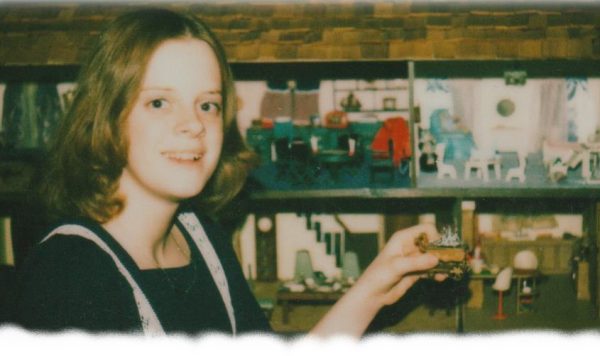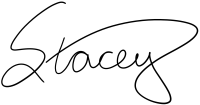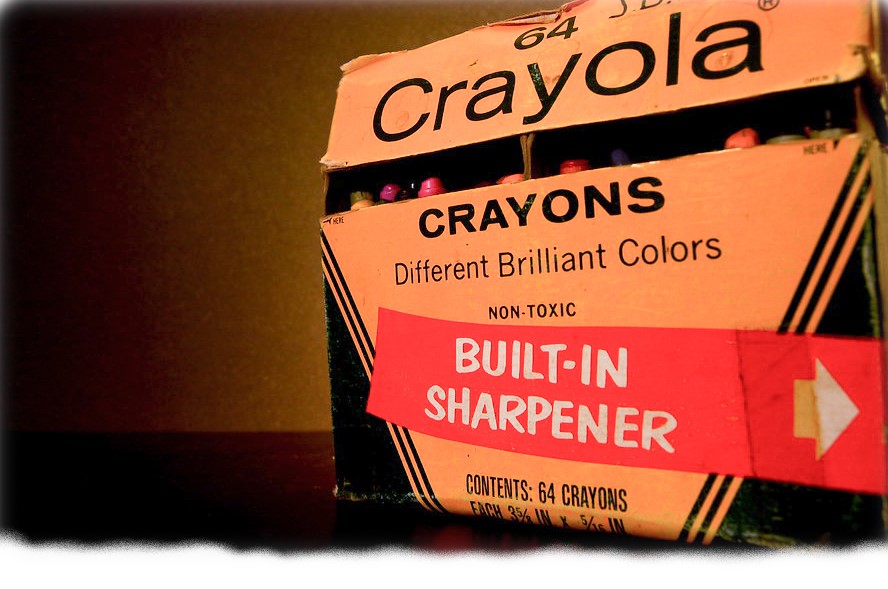Huge Lessons from Tiny Things

1 June 2019 | Theme: Creativity | 6-Minute Read | Listen
My mother taught me everything I know about creativity.
When I was in fourth grade, she told me that I was finally old enough to do the project she had always dreamt of doing with me: building a dollhouse.
We would begin with the two dolls she had from her childhood and the only furniture she had left—a bathtub and a toilet—and we would build the rest from scratch. Our scale would be 12:1—one foot in real life equals one inch in the dollhouse.
In 1970’s Tulsa, there were no places to buy ready-made miniatures, so we made everything ourselves. I remember asking a pharmacist for empty pill capsules so that we could make itty-bitty goblets for the dining table. (Take half a clear pill capsule, paint the “rim” gold, glue on a 3/8 inch section of spaghetti, attach to a circle of cardboard from a holepunch, paint the stem and base gold, and—voila! You’ve got a goblet!)
Over and over, we “created something from nothing.” Mom would show me a toothpaste cap and ask what we could make of it. I’d answer, “A lampshade! Or a wastebasket!” Tiny objects that would ordinarily go into the trash ended up becoming a globe, a figurine on a bookshelf, a set of perfume bottles, and more.
The project challenged both of us to think outside the box, and we were constantly looking for creative solutions. I recall the glee I felt when I solved the question of how we would make the sink for the lavatory, which had perplexed us for months. We were waiting outside a convenience store when I spied the gumball machines. “Mom, quick, give a dime!” I cried. She handed over the dime, and I popped it into the machine and got some trinket or toy that I quickly discarded so that I could triumphantly hold up the clear plastic bubble used to dispense it. “Look! We can use nail polish on the outside so that it’ll look like a porcelain sink!” Then she had the idea of gluing a small snap in the bottom to look like a drain. It was perfect.
Working on the dollhouse project required patience and adaptability, and I remember Mom demonstrating both the day we made miniature books. We had hundreds of book-shaped blocks of wood laid out on the table. Our plan was to paint three edges gold as if they were the pages, and then wrap each in a “book jacket” of colorful designs cut from magazines. Painstakingly, we dipped our brushes into the bottle of Tester’s metallic gold and applied the paint, until I accidentally knocked over the bottle. As the puddle of paint spread across the newspaper, Mom’s face brightened and she said, “Hey, look! We can do it this way!” She pinched a block of wood and quickly dipped three edges into the paint, set it aside, and grabbed the next.
The dollhouse also gave us a place to live out our design fantasies. I had always wanted a canopy bed, but my room was too small for one, so my mother used a potato peeler and a paring knife to carve four posters from dowel rods for a miniature canopy bed. I had always admired her friend Vera’s kitchen—decorated in 70’s orange—so we modeled the dollhouse’s kitchen after hers and “signed” it with a wallhanging of an owl, Vera’s favorite creature.
Eventually, we began to find trinkets when we would travel, but I was particular about what we added. Often as not, I’d look at a chest of drawers or living room chair and say, “No, it’s not to scale. We can make that.” Friends began to bring us treasures they had found, so our collection grew to include a toaster from my friend Sheila, a milk-lapping cat lapping from our friend Yoshi, and more.
Once we had created most of the furnishings, we began to plan the house itself, including electrified light fixtures and hinged doors. Tiny pebbles created a “rock” exterior, and slivers of real wood shingles covered the roof. Terrycloth towels were perfect as carpeting, and somehow we found paper with tiny prints that would serve as wallpaper.
When it was completed, the dollhouse was a five-foot-long, two-foot tall wonder, admired by adults and children alike. Everyone who visited our home wanted to see the dollhouse, and would gaze in amazement at all the detail we had put into every nook and cranny. I loved answering the inevitable, “How did you make that?”
Our project was about so much more than creating a finished product. Working together on it provided a true bonding experience for my mother and me, and it taught me incredible life lessons.
I discovered that creativity doesn’t really consist of making something from nothing. It comes from seeing a new way of using or combining the raw materials around us, and from letting the imagination sit with a problem until it sees a solution. I had to be willing to wade through the discomfort of not knowing the resolution of a challenge in order to experience the joy of that Eureka! moment.
I also felt the sense of accomplishment that comes from working on a project over a sustained period of time. Each item we created was its own tiny victory, but then putting it all together and building the actual house was a remarkable denouement.
Most importantly, I learned that “mistakes” and “failures” are often magical doorways to a different way of doing things. When I knocked over that bottle of paint, Mom could have reprimanded me for being “careless.” Instead, she showed me how to make the puddle of paint an opportunity to complete our task even more efficiently.
Think back, Dear Reader, to your own childhood. What positive lessons about creativity did you learn? Who guided you? Please post your comments on our Facebook page!
Until next time,

If you enjoyed this article,
please share on social media!
NEXT ARTICLE

Crayons
3 June 2019 | Theme: Creativity | 7-Minute Read
When I was in elementary school, summer days seemed to stretch to infinity. One day of eating honeysuckle nectar rolled into the next day of lying on a blanket, looking for shapes in clouds. If I rest for a moment and let my mind journey back, I can see my thumbnails, stained green from pinching flower. . .